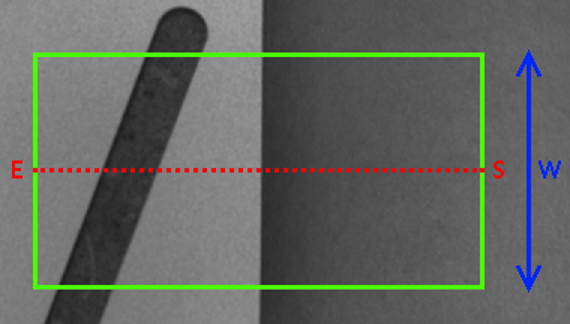F_VN_LocateEdgesExp
Locate the points of multiple occuring edges inside a specified search window with subpixel accuracy. (expert function)
Can use available TwinCAT Job Tasks for executing parallel code regions.
Can return partial results when canceled by Watchdog.
Syntax
Definition:
FUNCTION F_VN_LocateEdgesExp : HRESULT
VAR_INPUT
ipSrcImage : ITcVnImage;
ipEdgePoints : Reference To ITcVnContainer;
END_VAR
VAR_IN_OUT
aStartPoint : TcVnPoint2_REAL;
aEndPoint : TcVnPoint2_REAL;
END_VAR
VAR_INPUT
nNumEdges : UDINT;
eEdgeDirection : ETcVnEdgeDirection;
bAlternateDirection : BOOL;
fMinStrength : REAL;
nSearchLines : UDINT;
fSearchLineDist : REAL;
nMaxThickness : UDINT;
nSubpixelsIterations : UDINT;
fApproxPrecision : REAL;
eAlgorithm : ETcVnEdgeDetectionAlgorithm;
hrPrev : HRESULT;
END_VAR
VAR_OUTPUT
fAvgStrength : REAL;
END_VAR
 Inputs
Inputs
|
Name |
Type |
Description |
|---|---|---|
|
ipSrcImage |
Source image (1 channel) | |
|
ipEdgePoints |
Reference To ITcVnContainer |
Returns the detected edge points (ContainerType_Vector_Vector_TcVnPoint2_REAL) |
|
nNumEdges |
UDINT |
The (maximum) number of edges to search for |
|
eEdgeDirection |
Specification of the edge direction to search for | |
|
bAlternateDirection |
BOOL |
If true, eEdgeDirection is alternated after each detected edge. Else, only edges with eEdgeDirection are searched for. |
|
fMinStrength |
REAL |
Specification of the minimum strength (intensity difference) of the edge to search for |
|
nSearchLines |
UDINT |
Width of the search window, i.e. the number of search lines (1, 3, 5, 7, ...), centered around the line specified by aStartPoint and aEndPoint |
|
fSearchLineDist |
REAL |
Distance between the search lines in pixels (> 0) |
|
nMaxThickness |
UDINT |
Specification of the maximum thickness of the edge to search for, which means fMinStrength must be reached within nMaxThickness pixels |
|
nSubpixelsIterations |
UDINT |
Specifies the number of subpixels (for INTERPOLATION, 10 - 20 usually is sufficient) or maximum number of iterations for optimizing the parameters (for APPROX_ERF and APPROX_GAUSSIAN, 50 - 100 usually is sufficient) |
|
fApproxPrecision |
REAL |
Specifies the approximation precision for APPROX_ERF and APPROX_GAUSSIAN (0.001 usually is sufficient, unused for INTERPOLATION) |
|
eAlgorithm |
Selection of the edge detection algorithm | |
|
hrPrev |
HRESULT indicating the result of previous operations (If SUCCEEDED(hrPrev) equals false, no operation is executed.) |
 In/Outputs
In/Outputs
|
Name |
Type |
Description |
|---|---|---|
|
aStartPoint |
Position from which to start the search process (in the direction of aEndPoint) | |
|
aEndPoint |
Position where the search process ends |
 Outputs
Outputs
|
Name |
Type |
Description |
|---|---|---|
|
fAvgStrength |
REAL |
Returns the average strength of the detected edges |
Weiterführende Informationen
Die Funktion F_VN_LocateEdgesExp ist die Expert-Variante von F_VN_LocateEdges. Sie enthält zusätzliche Parameter.
Parameter
Eingangsbild
Das Eingangsbild ipSrcImage muss ein 1-kanaliges Grauwertbild sein.
Lokalisierte Punkte (Rückgabewert)
Der Container ipEdgePoints gibt die lokalisierten Punkte der linearen Kanten zurück.
Das Suchfenster
Zunächst einmal muss ein Suchfenster definiert werden, um festzulegen wo und in welcher Richtung nach einer Kante gesucht werden soll. Dies geschieht mit den Parametern aStartPoint, aEndPoint und nSearchLines. Das Suchfenster ergibt sich aus der Suchlinie von aStartPoint nach aEndPoint und parallel dazu (nSearchLines - 1) / 2 Suchlinien in jede Richtung, mit jeweils 1 Pixel Abstand. Somit definiert nSearchLines die Anzahl der Suchlinien und muss immer einen ungeraden Wert haben.
 Abb.15: S: StartPoint, E: EndPoint, W: WindowWidth
Abb.15: S: StartPoint, E: EndPoint, W: WindowWidthKantenstärke (Rückgabewert)
Der Rückgabewert fAvgStrength zeigt den tatsächlichen Kontrast der lokalisierten Kanten (gemittelt über alle Suchlinien) an.
Parameter zur Kantenlokalisierung
Die restlichen Parameter sind ausführlich im Kapitel Kantenlokalisierung erklärt.
Anwendung
Die Lokalisierung einer linearen Kante mit Expert-Parametern sieht z. B. so aus:
hr := F_VN_LocateEdgesExp(
ipSrcImage := ipImageIn,
ipEdgePoints := ipEdgePoints,
aStartPoint := aStartPoint,
aEndPoint := aEndPoint,
nNumEdges := nNumEdges,
eEdgeDirection := eDirection,
bAlternateDirection := bAlternateDirection,
fMinStrength := fMinStrength,
nSearchLines := nSearchLines,
fSearchLineDist := fSearchLineDist,
nMaxThickness := nMaxThickness,
nSubpixelsIterations := nSubpixIter,
fApproxPrecision := 0.001,
eAlgorithm := eAlgorithm,
hrPrev := hr,
fAvgStrength => fAvgStrength);Verwandte Funktionen
- LocateCircularArc zur Lokalisierung von anteiligen Kreisbögen
- LocateEdge zur Lokalisierung von linearen Kanten
- LocateEdges zur Lokalisierung von mehreren linearen Kanten
- LocateEllipse zur Lokalisierung von vollständigen Ellipsen
Required License
TC3 Vision Metrology 2D
System Requirements
Development environment | Target platform | PLC libraries to include |
|---|---|---|
TwinCAT V3.1.4024.59 or later | PC or CX (x64) with min. PL50, e.g. Intel 4-core Atom CPU | Tc3_Vision |